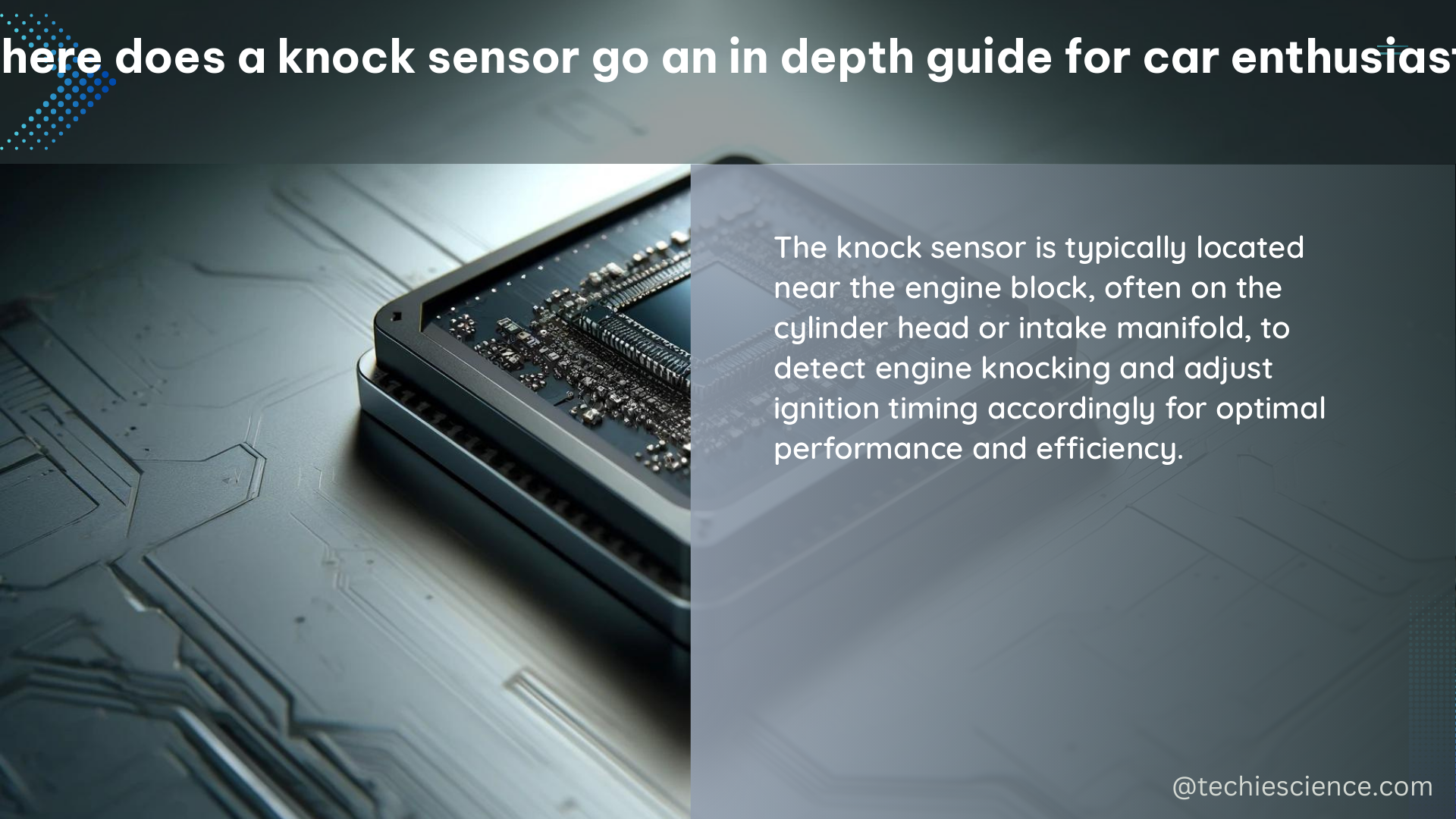A knock sensor, also known as a detonation sensor or a pinging sensor, is a crucial component in modern internal combustion engines. It is designed to detect engine knocking or pinging, a phenomenon that can cause significant engine damage if left unchecked. The knock sensor is typically mounted on the engine block or cylinder head, close to the combustion chamber, to detect vibrations caused by engine knocking.
Ideal Knock Sensor Placement
The ideal location for a knock sensor is in the center of the engine block, between cylinders 2 and 3, and as close to the top of the block deck as possible. This location allows the sensor to pick up vibrations from the combustion chamber without being affected by head or valve train noise. The sensor should be mounted as close to the cylinder as possible, typically within 2-3 inches, to ensure accurate detection of knocking.
Table: Ideal Knock Sensor Placement Specifications
| Specification | Value |
| — | — |
| Sensor Location | Center of engine block, between cylinders 2 and 3 |
| Sensor Proximity to Cylinder | 2-3 inches |
| Sensor Mounting | As close to top of block deck as possible |
However, on some engines, such as the LS-Vtec-turbo and B20-vtec engines, there may not be a factory knock sensor location. In such cases, alternative locations for sensor mounting include:
- Engine head
- Intake manifold
- Sump or front cover
- Cylinder head or intake manifold
These alternative locations may result in higher signal-to-noise ratios, which can affect the sensor’s ability to accurately detect engine knocking.
Knock Sensor Mounting Considerations

When mounting a knock sensor, it is essential to consider the engine’s design and configuration. Some engines may have spare threaded bosses that can be used for sensor mounting, while others may require drilling and tapping new holes. The sensor’s orientation is also crucial, as mounting it horizontally or vertically can affect its sensitivity to vibrations.
It is important to ensure that the knock sensor is securely mounted and that the mounting surface is clean and free of any debris or contaminants. Improper mounting can lead to false readings or sensor failure, which can result in engine damage.
Knock Sensor Types and Frequency Ranges
The signal from the knock sensor is transmitted to the engine control unit (ECU), which uses it to adjust ignition timing and fuel injection to prevent engine knocking. The ECU may use either a wideband piezoelectric sensor or a resonance piezoelectric sensor, depending on the engine’s design and the sensor’s frequency range.
Wideband sensors pick up vibrations within a broad frequency range, typically between 2,000 and 20,000 Hz, while resonance sensors only respond to vibrations within a specific frequency range, typically between 5,000 and 9,000 Hz.
Table: Knock Sensor Types and Frequency Ranges
| Sensor Type | Frequency Range |
| — | — |
| Wideband Piezoelectric | 2,000 – 20,000 Hz |
| Resonance Piezoelectric | 5,000 – 9,000 Hz |
The choice of sensor type and frequency range is crucial, as it must be compatible with the engine’s design and the specific knocking characteristics of the engine.
Knock Sensor Testing and Diagnostics
To test a knock sensor, professionals typically force the engine to ping while monitoring the sensor’s output signal. This method is more effective than the older tap test, which only works on wideband sensors.
When testing a knock sensor, it is important to check for the following:
- Sensor output voltage: The sensor should produce a voltage signal that varies with engine knocking.
- Sensor frequency response: The sensor should respond to vibrations within the appropriate frequency range (2,000 – 20,000 Hz for wideband, 5,000 – 9,000 Hz for resonance).
- Sensor mounting and wiring: The sensor should be securely mounted, and the wiring should be free of any damage or interference.
If the knock sensor is not functioning properly, it can lead to issues such as engine knocking, poor fuel efficiency, and even engine damage. In such cases, the sensor should be replaced to ensure the engine’s proper operation and longevity.
Conclusion
In summary, the knock sensor is a critical component in modern internal combustion engines, designed to detect engine knocking and prevent engine damage. The ideal location for a knock sensor is in the center of the engine block, between cylinders 2 and 3, and as close to the top of the block deck as possible. However, alternative locations may be necessary on some engines, and the sensor’s orientation and mounting method must be carefully considered.
The signal from the knock sensor is used by the ECU to adjust ignition timing and fuel injection, and the sensor’s frequency range and type must be compatible with the engine’s design. Proper testing and diagnostics are essential to ensure the knock sensor is functioning correctly and to prevent any issues related to engine knocking.
References:
– HP Academy Webinar: 203 | Ideal Knock Sensor Placement
– Knock Sensor Replacement – YouTube
– HP Academy Forum: Knock Sensor Locations
– CarParts.com Blog: Bad Knock Sensor: Common Symptoms and Testing Procedure
– YouTube: WHAT IS A KNOCK SENSOR, WHERE IS THE KNOCK SENSOR, CAN YOU DRIVE WITH BAD KNOCK SENSOR

The lambdageeks.com Core SME Team is a group of experienced subject matter experts from diverse scientific and technical fields including Physics, Chemistry, Technology,Electronics & Electrical Engineering, Automotive, Mechanical Engineering. Our team collaborates to create high-quality, well-researched articles on a wide range of science and technology topics for the lambdageeks.com website.
All Our Senior SME are having more than 7 Years of experience in the respective fields . They are either Working Industry Professionals or assocaited With different Universities. Refer Our Authors Page to get to know About our Core SMEs.